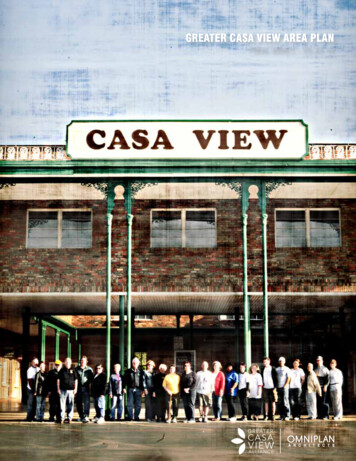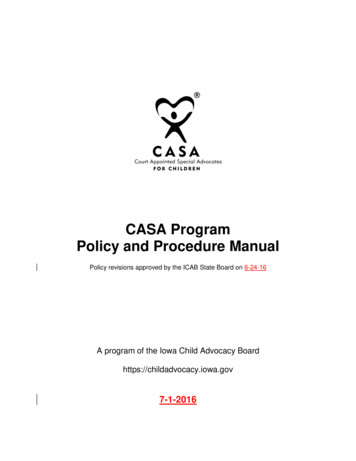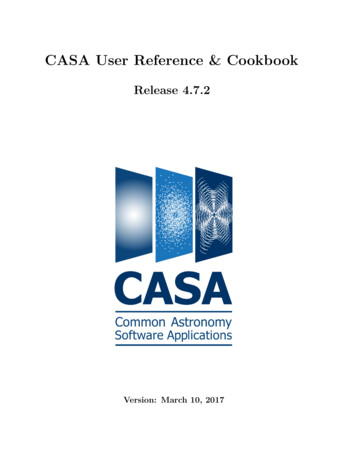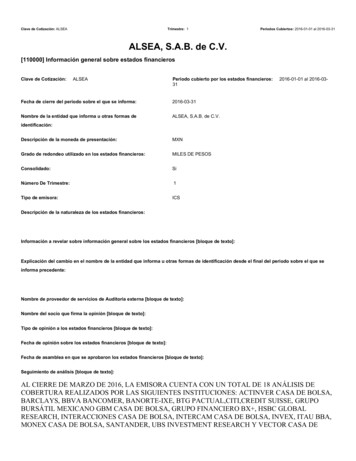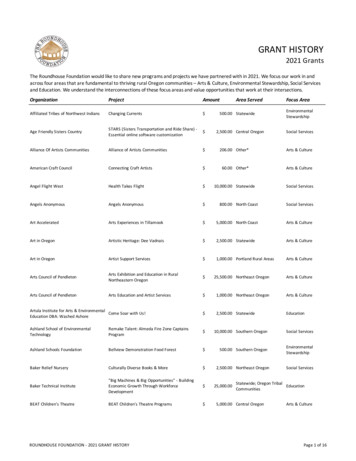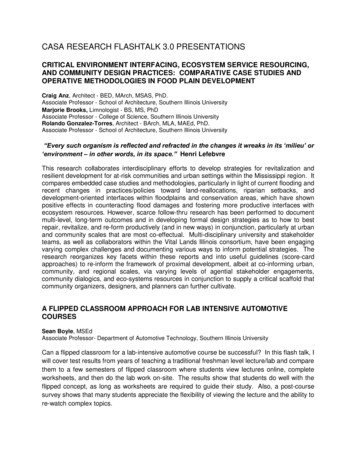
Transcription
CASA RESEARCH FLASHTALK 3.0 PRESENTATIONSCRITICAL ENVIRONMENT INTERFACING, ECOSYSTEM SERVICE RESOURCING,AND COMMUNITY DESIGN PRACTICES: COMPARATIVE CASE STUDIES ANDOPERATIVE METHODOLOGIES IN FOOD PLAIN DEVELOPMENTCraig Anz, Architect - BED, MArch, MSAS, PhD.Associate Professor - School of Architecture, Southern Illinois UniversityMarjorie Brooks, Limnologist - BS, MS, PhDAssociate Professor - College of Science, Southern Illinois UniversityRolando Gonzalez-Torres, Architect - BArch, MLA, MAEd, PhD.Associate Professor - School of Architecture, Southern Illinois University“Every such organism is reflected and refracted in the changes it wreaks in its ‘milieu’ or‘environment – in other words, in its space.” Henri LefebvreThis research collaborates interdisciplinary efforts to develop strategies for revitalization andresilient development for at-risk communities and urban settings within the Mississippi region. Itcompares embedded case studies and methodologies, particularly in light of current flooding andrecent changes in practices/policies toward land-reallocations, riparian setbacks, anddevelopment-oriented interfaces within floodplains and conservation areas, which have shownpositive effects in counteracting flood damages and fostering more productive interfaces withecosystem resources. However, scarce follow-thru research has been performed to documentmulti-level, long-term outcomes and in developing formal design strategies as to how to bestrepair, revitalize, and re-form productively (and in new ways) in conjunction, particularly at urbanand community scales that are most co-effectual. Multi-disciplinary university and stakeholderteams, as well as collaborators within the Vital Lands Illinois consortium, have been engagingvarying complex challenges and documenting various ways to inform potential strategies. Theresearch reorganizes key facets within these reports and into useful guidelines (score-cardapproaches) to re-inform the framework of proximal development, albeit at co-informing urban,community, and regional scales, via varying levels of agential stakeholder engagements,community dialogics, and eco-systems resources in conjunction to supply a critical scaffold thatcommunity organizers, designers, and planners can further cultivate.A FLIPPED CLASSROOM APPROACH FOR LAB INTENSIVE AUTOMOTIVECOURSESSean Boyle, MSEdAssociate Professor- Department of Automotive Technology, Southern Illinois UniversityCan a flipped classroom for a lab-intensive automotive course be successful? In this flash talk, Iwill cover test results from years of teaching a traditional freshman level lecture/lab and comparethem to a few semesters of flipped classroom where students view lectures online, completeworksheets, and then do the lab work on-site. The results show that students do well with theflipped concept, as long as worksheets are required to guide their study. Also, a post-coursesurvey shows that many students appreciate the flexibility of viewing the lecture and the ability tore-watch complex topics.
QUANTITATIVE ANALYSES OF DEMOGRAPHICS AND REMINDERS REGARDINGFAILED APPOINTMENTSAmy Bro, MSRSClinical Instructor, Radiologic Sciences, School of Allied Health, Southern Illinois UniversityKatlynn Hutchcraft, MPHAssistant Lecturer, Radiologic Sciences, School of Allied Health, Southern Illinois UniversityFailed appointments negatively impact healthcare facilities. At the SIU Dental Hygiene Clinic, afailed appointment can be a revenue loss of up to 900. We will look at the failed appointmentsof the SIU Dental Hygiene Clinic to determine a common factor. The parameters recorded werethe use of telephone reminders and primary payment methods. The data was analyzed to arriveat the conclusion that although telephone reminders had no significant effect on failedappointments, patient means of payment held significance.UTILIZING FLIGHT DATA MONITORING TO EXAMINE FLIGHT INSTRUCTORMODELINGJ. Kenneth BroChief Flight Instructor, Department of Aviation Management & Flight, Southern Illinois UniversityMichael F. Robertson, Ph.D.Associate Professor, Department of Aviation Management & Flight, Southern Illinois UniversityFlight Data Monitoring (FDM) is designed to continuously monitor and ensure that all flightoperations are safe and in compliance with operating standards and regulations. An FDMprogram assists organizations in identifying and addressing operational deficiencies and trendsthat are not generally detectable with other procedures. Instructor modeling is a form of latentlearning, wherein the student gleans habits and mannerisms from their instructor. Often instructormodeling is used to embody professional characteristics and positive behaviors; examplesinclude: punctuality, etiquette, and honesty. This research focuses on identifying instructormodeling of negative behaviors utilizing FDM data over a seven-year period. The initial findingsuncover a pattern of risky behavior being demonstrated by a flight instructor, replicated by astudent, and then, as the student progresses to become an instructor, the behavior repeats inanother generation. By comparing the total number of abnormal flight events to the number ofabnormal events with a traceable genealogy, we are able to demonstrate a significant portion ofabnormal behavior may be due to instructor modeling. Incidental findings have led to thepreliminary conclusion that instructors can model poor aeronautical decision-making (ADM) withthe student imitating this behavior.
ADVANCED INTERACTIVE ROBOT USES PREFERRED BEHAVIORS TO IMPROVEPATIENT OUTCOMESSandra Collins, PhD.Professor, Health Care Management - School of Allied Health, Southern Illinois UniversityValerie Boyer, MPA, PhD.Associate Professor, Rehabilitation Institute, Southern Illinois UniversityRick McKinnies, MSEdAssociate Professor, Radiologic Sciences - School of Allied Health, Southern Illinois UniversityStacey McKinney, RDH, MSEdAssistant Professor, Dental Hygiene - School of Allied Health, Southern Illinois UniversityPARO is an advanced interactive robot that utilizes artificial intelligence technology to reducepatient stress, stimulate interaction between patients and caregivers, and improve relaxation andmotivation. Designed to look and sound like a baby harp seal, PARO uses five kinds of sensorsto perceive people and the environment including tactile, light, auditory, temperature, and posture.Invented for use in areas where live animal therapy may not be suitable, PARO learns to respondbased on the preferred behaviors of the user. In the largest dementia case study of its kind in theUnited States, PARO was shown to reduce patient symptoms which decreased the amount ofneeded medication by 30%. Furthermore, the calming effect of the therapeutic seal lasted almosttwo hours longer than many of the commonly used anxiety drugs given to elderly dementiapatients.2 PARO, to be named Sammy, will join the School of Allied Health at Southern IllinoisUniversity Carbondale (SIUC) in the spring of 2019. Initially, researchers are investigatingSammy’s potential use in collaboration with SIUC’s Center for Autism Spectrum Disorders, butaspire to launch research projects in a variety of other areas as well.ANOTHER WAY TO REDUCE DIESEL EMISSIONSAndrew Croxell, MSEdAssistant Professor, Department of Automotive Technology, Southern Illinois UniversityMultiple makes and models of diesel vehicles have been in trouble for producing too much of thepollutant known as ‘NOx.’ NOx is formed from high combustion chamber temperatures and thenis supposed to be ‘scrubbed’ in an emissions after-treatment system. This research looks at asimple system known as water/alcohol injection that can be added to cool the combustionchambers in diesel vehicles as a means to greatly reduce the amount of NOx that is created inthe first place.
THE RAMIFICATIONS OF TEACHING DESIGN STUDIO ONLINEJon Daniel Davey, PhD., AIADistinguished Professor, School of Architecture, Southern Illinois UniversityDuring the late 1980s, I presented myself as a “techno-evangelist” and am now today teaching designstudio online, in particular the final thesis project. This study and reflection is a review of the processand product of these projects now in its third year. With the advent of the smartphone, blockchain,bitcoin, the internet of things, augmented reality, 3D printing, real-time conferencing and artificialintelligence teaching, architecture has changed and so have the students of architecture. Greenfieldin his text Radical Technologies: The design of everyday life, which some liken to the work of JaneJacobs repeats Winston Churchill’s famous dictate, “We shape our building and afterwards they shapeus.” He continues on “Now we make networks, and they shape us every bit as much as any buildingever did, or could.” Some fellow architects question the online approach as noted in Peter Raisbeck’sFace to Face vs. Online Teaching: The destruction of culture in architectural schools, ” the ability toformulate architectural ideas, concepts, schema, systems, forms, compositions, theories and ways ofknowing in practice is best taught through a vibrant educational culture. A culture which understandsand puts face to face teaching first is central in this endeavor. In our universities and architectureschools architects will need to fight to preserve the integrity of their education systems and their canonagainst the onslaught of mindless managerialism disguised as “innovation.” Our student’s brains arebeing restructured via “technology” maybe sometimes not for the best. A report published in the journalCurrent Biology, notes that London Cabbies learning the mental atlas of London's spaghetti streetscauses structural changes in the brain which affects memory and creates a greater volume of nervecells in the brain's hippocampus. With Google Maps and other directional apps a person’shippocampus is smaller. The study investigates the current ramifications of not only online studioteaching but also the effect that these technologies have upon architectural pedagogy.THE GENDER WAGE GAP OF CIVIL SERVICE EMPLOYEES AT ILLINOIS PUBLICFOUR-YEAR UNIVERSITIESCara Doerr, MAEd, PhD.Recruitment & Retention Coordinator, College of Applied Sciences & Arts, Southern Illinois UniversityDespite the progress women have made in education and the workforce over the past severalcenturies, challenges and inequities remain. There is deep-rooted gender segregation withinthe academy for both female students and female faculty, staff, and administrators. Womenoutnumber men in attainment of all degree types yet men outnumber women in all faculty ranksand in administrative and leadership roles at all types of four-year institutions. There arenumerous studies on gender discrepancies in higher education for students, faculty, andadministrators; however, there is little research of the relationship between male and femalenon-instructional academic staff on university campuses. The study examines non-instructionalcivil service staff member’s average salary broken out by gender (male and female) from theseven largest four-year public universities in Illinois in the professional, semi-professional,managerial, and clerical occupational classifications within the State Universities Civil Service
System. In addition to gender theory and theorizing universities as gendered organizations,explored are the implications of unions and collective bargaining agents for non-instructionalacademic staff on university campuses. Included is a review of the salary distributions,discrepancies, inequalities, and inequities that exist within U.S. institutions of higher education.The findings indicate gendering of positions and gender wage discrepancies exist on all sevenIllinois public university campuses in the study despite the highly bureaucratic and detailedsalary rates and labor policies of the State Universities Civil Service System.PUBLIC PERCEPTION OF AIRLINE SAFTEYSteven C. Goetz, MSEdAssistant Professor, Department of Aviation Management & Flight, Southern Illinois UniversityMatthew J. Romero, MPAAssistant Professor, Department of Aviation Management & Flight, Southern Illinois UniversityPublic perception is a powerful force. Public perception can sway decisions and influencedecision makers regardless of the data. Public perception can create its own truth and should beof great concern to aviation. There have been numerous events in recent years that have sheda negative light on the airline industry. From forcefully removing passengers on flights toaccidental pet deaths to the recent accidents of Lion Air 610 and Ethiopian Air 302. If theperception of safety in air carriers is disturbed, it can have repercussions throughout the industryas the public generally does not differentiate between the aviation industry and the airlines. Thisresearch is proposed to survey the public accessible through social media and Amazon’s M-Turkservice to determine if the recent media attention on global airline service has impacted theperception of the safety of the US airline industry and to what extent. We propose to take aconvenience sample from social media and Amazon M-Turk. While not perfect tools, both socialmedia and M-Turk has been used effectively in survey research in the past (Buhrmester, Kwang,& Gosling, 2011; Fryrear, 2015; Paolacci & Chandler, 2014; Wright, 2005).EXPANDING INSTRUCTIONAL OPPORTUNITIESTodd GrantAssistant Instructor, Department of Automotive Technology, Southern Illinois UniversityThis presentation will discuss how the Department of Automotive Technology at Southern eprogram.
WASTE MOTOR OIL TO DIESEL FUEL PROJECTBlaine M. Heisner, MSEdAssistant Professor, Department of Automotive Technology, Southern Illinois UniversityIt is estimated that over 1.3 billion gallons of waste motor oil (WMO) are generated each year inthe United States. SIUC alone is responsible for multiple thousands of these gallons. WMO istypically collected and re-refined into products such as lubricants and asphalt. In the past, WMOwas a valuable commodity and generators were paid for the product. Due to recent softness inthe petroleum market, generators now have to pay a fee to have WMO disposed. Our projectfocuses on collecting SIUC generated WMO and converting it into a useable diesel fuel forUniversity vehicles. Not only will this save WMO disposal costs, it saves on fuel costs as well.Thanks to an initial funding from the SIUC Green Fund, we have a working WMO processor. Wehave also successfully tested the fuel in multiple vehicles. Our plan is to expand the project tocollect and repurpose all SIUC generated WMO into diesel fuel.MACHINE LEARNING-DRIVEN COAL QUALITY ANALYSIS AND PREDICTION FORMINIMIZING POLLUTING GAS GENERATIONS IN COAL-FIRED POWER PLANTSQian (Jenny) Huang, PhD.Assistant Professor, School of Architecture, Southern Illinois UniversityMachine learning is changing the future of energy. At present, big data and machine learning playan important role in coal-fired power generation. Despite their increasing prevalence, there arestill unrealized opportunities in the rapid coal quality analysis, which fully and effectively utilizescoal resources and reduce polluting gas emissions. Boiler efficiency can be increased whenthey are fed a real-time known coal quality. In addition, coal consumption is reduced, harmfulgas emissions are lessened, maintenance is minimized, and unplanned outages are avoided.After rapidly knowing the coal quality, pro-active control decisions can be made to improvethe efficiency of power plants. Up to date, existing rapid coal quality analysis methodshave a low degree of automation, a long analysis time, and cannot timely feedback the quality ofcoal in the process of coal processing and utilization. To address this critical challenge, wepropose to generate spectra of coal samples using laser-induced breakdown spectroscopy(LIBS) and Fourier transformed infrared spectroscopy (FT-IR), respectively. The SIU powerplant will provide us with sufficient coal samples and their corresponding analysis reportprovided by third-party chemical analysts. Based on the spectra obtained by LIBS and FT-IR aswell as the analysis reports provided by the SIU power plant, we will investigate and explore variousmachine learning algorithms to model the coal properties hidden in the coal spectrum. Theoutcome of this research is the development and determination of a new high-precision, lowcomplexity, machine learning-driven, rapid coal analysis method, which can capture thecomprehensive chemical nature of coal samples. This project is of great significance and broadprospect for rational utilization of coal resources and promoting sustainable coal-fired powerplants.
A MULTIDISCIPLINARY COLLABORATION: FASHION & ELECTRICAL ANDBIOMEDICAL ENGINEERINGSeung-Hee Lee, PhD.Professor, Fashion Design & Merchandising Program, School of Architecture, Southern Illinois UniversityJun Qin, PhD.Associate Professor, Electrical & Computer Engineering, Southern Illinois UniversityYuli Liang, PhD.Lecturer, Fashion Design & Merchandising Program, School of Architecture, Southern Illinois UniversityIn recent years, fashion and technology have become more integrated, resulting in more digitalinnovation. Thus, fashion designers and marketers need to be able to predict how consumers'fashion adoption is affected by new technologies. To understand this current phenomena, thosethe fashion industry or fashion academic area need to understand and adopt digital innovation ina more efficient and creative way. The more collaboration between teams, the more innovativefashion products will be developed, and the more fashion consumers will have access to newproducts. This collaboration work will help fashion designers and marketers improve thecreativeness and effectiveness of fashion products for their fashion business. Thus, last year amultidisciplinary collaboration team between Fashion and Electrical and Biomedical Engineeringwas formed. For this research forum, we will share what we have already done, what we aredoing now, and what we will do next for further research.FAMOUS IN A SMALL TOWN: EXPLORING ELITE SOCIAL NETWORKS IN RURALCOMMUNITIESScott McClurg, PhD.Acting Director, School of JournalismProfessor, Department of Political Science & School of Journalism, Southern Illinois UniversityMalinda SupriseDoctoral Candidate, Applied Psychology, Southern Illinois UniversityViloshanakumaran VeeramaniDoctoral Candidate, Applied Psychology, Southern Illinois UniversityAlan FranklinDoctoral Candidate, Applied Psychology, Southern Illinois UniversityThe goal of this research is to better understand how community perceptions operate within socialnetworks of elite members of small, rural communities. Participants (N 63) were surveyed aboutthe structure of their social networks and about their individual characteristics, beliefs, andperceptions of their communities. Social network analysis (SNA) techniques and communityperceptions will be discussed along with directions for future analyses.
TRANSPORTATION AND AFFORDABLE HOUSING LINKAGESShannon Sanders McDonald, MArchAssociate Professor, School of Architecture, Southern Illinois UniversityCreating successful affordable housing is directly related to transportation and their connectionsand interrelationships are currently being explored across the country. A grant from theMineta Transportation Institute brought together many academics and professionals from aroundthe country to seek the most innovative ideas that are being implemented to create moreaffordable housing. Working with Home for All, the grant was supported by San Mateo County,CA where the problem of affordable housing is particularly acute. A four person family with amedian income of 117,400.00 at 80% of the area median income is eligible for housingassistance in San Mateo County. The intent of the grant was to produce a toolkit of strategiesthat municipalities could implement to create affordable housing. The presentation will coverthe top case study ideas of parking, land use and accessibility to transit along with innovative datacollection strategies in order to understand the specific challenges.From architectural toplanning, data collection and changes to the laws and guidelines, the case studies and toolkithopefully will assist with this challenging problem.INTERDISCIPLINARY COLLABORATION BETWEEN DENTAL HYGIENISTS ANDCANCER TREATMENT FACILITIESStacey L. McKinney, RDH, MSEdAssistant Professor, Dental Hygiene, Southern Illinois UniversityJennifer S. Sherry, RDH, MSEdAssociate Professor, Dental Hygiene, Southern Illinois UniversityOral complications have major effects on treatment, quality of life, and overall survival. Thesecomplications can affect the proposed course of treatment, treatment dose, location of head andneck radiation therapy, and even the ability to continue treatment. If patients cannot continuetreatment or the regimen is adjusted, the risk of tumor growth and recurrence increases(ultimately leading to decreased survival rates). Moreover, if the hospital or cancer treatmentfacility does not have a dentist or dental hygienist on staff, this can be a barrier to care. Ourresearch will initially survey radiation oncologists in cancer treatment facilities in Illinois. Datawill be gathered to determine radiation oncologists’ attitudes regarding the collaborationbetween dental hygienists and how their utilization in these treatment facilities affects thepatients’ oral conditions throughout their treatment process.
PROBLEMS EXPEIRIENCED WITH AIRDUINO AND MOVING FORWARDDon Morris, MASAssistant Professor, Department of Aviation Technologies, Southern Illinois UniversityWhile the current published Airduino configuration makes an attractive and economical package,system accuracy is demonstrably lower than the sensor manufacturer’s publishedspecifications. This is primarily attributed to the manufacturer’s firmware being optimized forrapidly moving dynamic systems such as quad-copters and remote cameras. These differsignificantly from the dynamic but more sustained forces which typically occur in manned aircraftflight. This ongoing research reports on other sensors that are being investigated, as well as thepotential development of new firmware. This would free up the Airduino to begin flight tests in anexperimental aircraft currently being prepared for this role. This is an ongoing research report,and includes an invitation for interested parties to join in this research.A NEW PERSPECTIVE ON FEDERAL GOVERNMENT DEFICITS, DEBT, ANDTRUST FUNDSSamuel R. Pavel, MA, MDiv, PhD.Associate Professor, Department of Aviation Management & Flight, Southern Illinois UniversityThis presentation uses an emerging school of economic thought called Modern Money Theory(MMT) to analyze Federal Government fiscal and monetary policy. MMT expands on a variety ofsources to understand how an economy with sovereign issued money operates, including:Monetary theory developed by economists Keynes, Innes, Knapp, and Minsky; Functional financedeveloped by Learner; Bufferstock and monopoly price setting developed by Minsky, Mitchell,and Mosler; Sectoral Balance accounting developed by Godley.The foundation of MMT standson nine concepts: 1) Money is an IOU denominated in a socially sanctioned state chosen unit ofaccount; 2) Taxes (including fees, fines, tribute, tithes, and like payments) drives the use of themoney by accepting the state money in payment (“redemption”); 3) Anyone can issue money, butacceptance of the money is difficult without state backing; 4) Sovereign debt is different than anyother debt; 5) Finance should be “functional” – (to achieve a public purpose) not “sound” (toachieve an arbitrary balance between spending and revenue); 6) A Job Guarantee program toremove any involuntary unemployment; 7) Any financial system is inherently unstable; 8) Federalgovernment debt is a financial asset; 9) The central bank is independent of the treasury and nota potent economic stabilizer. The Airport and Airway Trust Fund (Trust Fund) was established in1970 to help finance the FAA’s investments in airports and the National Airspace System (NAS).Revenue for the Trust Fund is generated by a series of excise taxes levied on the users of theNAS. My research indicates that funding this important national infrastructure using a Trust Fundis inefficient and unfair. Analysis using MMT shows there is a more efficient way of fundingimportant FAA programs than relying on the Trust Fund.
ANNA HE PURNABRAMHA: WOMEN’S AGENCY IN THE MAKING OF BODIES,CUISINES, AND CULTURE IN MAHARASHTRA, INDIAGauri A. Pitale, PhD.Assistant Professor of Practice, Saluki Success Program & Anthropology, Southern Illinois UniversityThe world is changing. India is changing. Food is changing. Bodies are changing. What doesthis mean for the women of Maharashtra, India? Globalization and modernity manifest in newand interesting ways the world over. As people establish networks of global commodity, capital,and human circulation, anthropologists raise pertinent concerns. While some are apprehensiveabout cultural loss and western cultural imperialism, others make a case for the rise ofglobalization. While some espouse the positives of a free market economy, others are critical ofthe nutrition transition in developing countries and what this means for the health of the peopleundergoing this transition. The site of this study is the region of Konkan in Maharashtra, India.India is undergoing fast-paced culture change since liberalizing its economy in the year 1991. Ifocus on the experiences of present day rural and urban Deorukhe Brahmin women (mothersand their daughters), who belong to an endogamous upper caste group that claims to beindigenous to Konkan. Generally, rural Indian regions are modernizing more slowly than urbanareas. This study looks at how women are active agents in the changes that are taking place intheir bodies, diet, and gender identities. A biocultural study, this dissertation takes intoconsideration anthropometric data and ethnographic data to comprehend the manner in whichwomen, who are the gastronomic decision makers at the household level, are responding to theincreasing influx of non-traditional foods. My study focuses on the moral implications of changingdietary practices and the appearance of chronic non- communicable diseases on the notions ofthe self. By discussing the manner in which Indian women practice their agency, using traditionalgender roles, I aim to demonstrate how these women adjoin that which is thought to index theglobal and the local to shape a new India.SPIRITUAL BELIEFS AMONG INDIVIDUALS WITH DEMENTIA AND APPROPRIATEFAITH-BASED INTERVENTIONSRobert Rados, PhD.Assistant Professor, Health Care Management Program, Southern Illinois UniversityTo investigate the influence of “spiritual belief” among individuals with dementia (IwD) living in amemory care center, this exploratory study will conduct a mixed method research design toexamine the conceptualization and operationalization of faith as a measure of belief. Participants’current spiritual state (i.e., level of spiritual well-being vs spiritual distress) will be identified basedon published spirituality instruments and used to guide selection of appropriate faith-basedinterventions matched with the individual’s level of spirituality, religion and personal beliefs. Areview of faith-based literature associated with IwD will be used to identify and adapt existinginterventions and research methods. Qualitative information from participants may provide abetter understanding of how conscious effects of spirituality prevail for IwD and its connection in
association with their recognition of self-well-being. The holistic philosophy of person-centeredhealthcare acknowledges a wide range of individual needs including cultural, spiritual, andreligious.APPLYING THE PSYCHOMOTOR VIGILANCE TEST TO FATIGUE MANAGEMENTTRAININGMatthew J. Romero, MPAAssistant Professor, Department of Aviation Management & Flight, Southern Illinois UniversitySteven C. Goetz, MSEdAssistant Professor, Department of Aviation Management & Flight, Southern Illinois UniversityFatigue was a contributing factor in numerous aircraft accidents since the 1970’s and was foundto contribute to 23% of aircraft accidents that occurred between 2001 and 2012 (Marcus &Rosekind, 2017). As a result, the Federal Aviation Administration (FAA) regulates flight dutylimits, crew rest requirements, and fitness for duty requirements in commercial aviation (14 C.F.R.§ 117, 2013) to reduce the risks associated with fatigue in operational settings. This study aimsto understand the degree to which fatigue impacts flight student check ride performance byadministering the psychomotor vigilance test (PVT) before those evaluative situations. The PVTis used to measure fitness for work evaluations “by providing objective, quantitative assessmentof alertness deficits” (Lerman, Mollicone, & Coats, 2017, p. 716). The PVT requires users torespond to visual stimuli to evaluate alertness levels based on the timeliness and accuracy oftheir responses to the stimuli. The results of the PVT will be compared to the result of the flightportion of a check ride to see if any relationships exist between PVT scores and success or failureon the check ride.HOTSPOTTING: LEARNING BY DOING-BUILDING INTERDSCIPLINARY BRIDGESLEADING TO IMPROVED OUTCOMESThomas Shaw, Ph.DAssociate Professor, Health Care Management Program, Southern Illinois UniversityJessica Cataldo, MPHClinical Instructor, Health Care Management Program, Southern Illinois UniversitySandra Collins, Ph.DProfessor, Health Care Management Program, Southern Illinois UniversityThis is an interprofessional learning collaborative sponsored by The National Center for ComplexHealth and Social Needs; the Cam
Assistant Lecturer, Radiologic Sciences, School of Allied Health, Southern Illinois University Failed appointments negatively impact healthcare facilities. At the SIU Dental Hygiene Clinic, a failed appointment can be a revenue loss of up to 900. We will look at the failed appointments of the SIU Dental Hygiene Clinic to determine a common factor.
